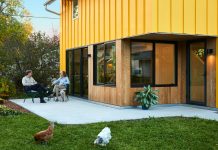Running into Shane Coen is always a delight. Sure, interviewing him for articles in Landscape Architecture or Midwest Home reveals new insights into his “minimalist-modern approach to landscape architecture and residential living,” as he said in the Midwest Home Q+A. But to meet him on the street, as I did a year or so ago, in Prospect Park where new housing developments and retail are transforming that neighborhood’s edge along adjacent train yards and milling silos, is to experience the vibrancy of his personality in full. Along with the sense of possibility with which Coen seems to greet every prospect for nature and culture to find common ground.

So it’s about time Coen and his Minneapolis firm, Coen+Partners, who came to fame for designing the landscape for architect David Salmela and developer Harold Teasdale’s award-winning Jackson Meadow in Marine on St. Croix, have a gorgeously illustrated monograph published. Coen+Partners: Contextual Minimalism: Landscape Architecture and Urbanism, has just been released by Princeton Architectural Press. Showcasing 200 color photographs of the firm’s residential and civic work, with minimal expository text, the book demonstrates just how beautifully the firm realizes “contextual minimalism” in both the public and private realms.
A coffee-table tome that doubles as a reference book, Coen+Partners: Contextual Minimalism elucidates why the firm received the 2015 National Design Award in Landscape Architecture from the Cooper Hewitt Smithsonian Design Museum. Note the ways in which the firm’s comprehensive rethinking of site for the Speckmann House in St. Paul, a modernist treasure, incorporates a series of walls that create outdoor rooms, some populated with precisely placed birch trees. In Jackson Meadow, trails and plantings of little bluestem fill the spaces between houses.
A home near Bde Maka Ska (Lake Calhoun) in Minneapolis features outdoor areas defined by a custom teak gate as well as stone walls, to demarcate an outdoor kitchen, bronze-clad fireplace, and garden court anchored by Japanese yews and birch trees. A home in Arizona is surrounded by native desert plants planted in grids. A house in California has an allée of olive trees arching protectively overhead.
Often mono-cultural in expression, in an era in which native-plant diversity better serves the needs of pollinators and animal life, Coen’s landscapes are nonetheless extremely Zen: serene, meditative, and beautiful to behold. In the landscape for the Lake Marion Residence, a 22-acre estate, the firm extends its methodology to create quiet opportunities to enter the wetlands, oak savanna and maple-basswood forest.
As Coen writes in the book’s introduction, “We have always believed that any landscape will communicate in the form of ideas if you take the time to understand the space and are quiet enough to listen and be receptive.” At the same time, Coen and his firm continue to work at “elevating design at all levels…. When the elements maintain an integral link to context and place and there is a rigorous commitment to telling an authentic story through details, the landscape will resonate with those who experience it.”

















